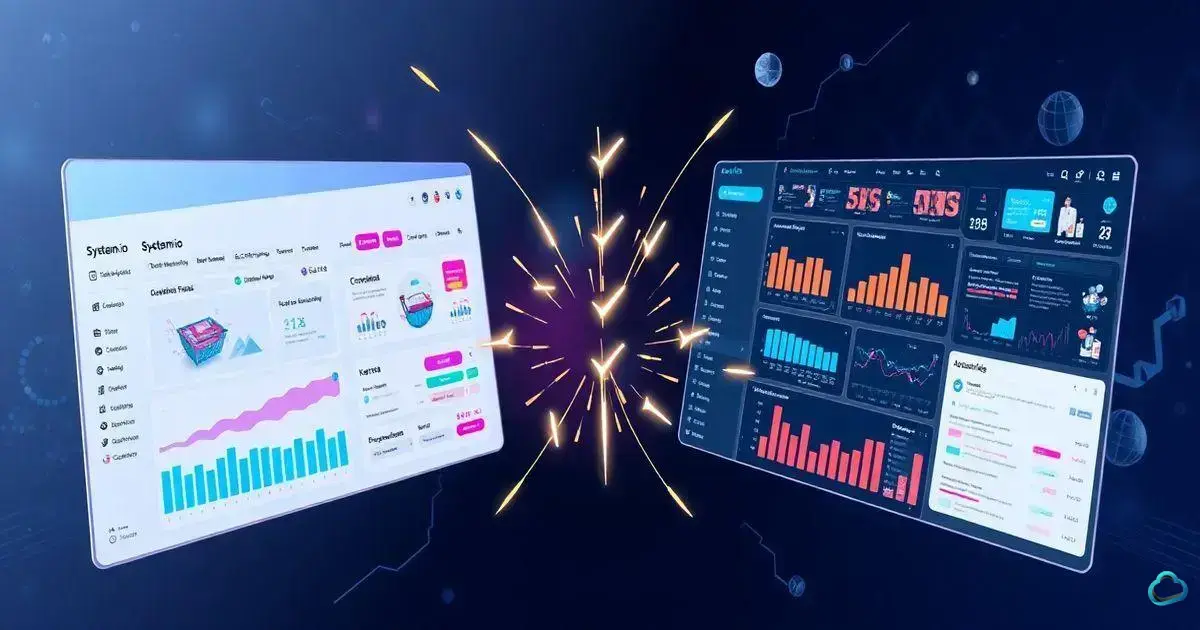Contents
- 0.1 Understanding the ROI of premium SaaS plans is crucial for businesses to evaluate the profitability of their investments. Key metrics such as Customer Acquisition Cost (CAC) and Customer Lifetime Value (LTV) help assess financial viability, while both direct and indirect benefits contribute to long-term success.
- 0.2 By evaluating costs, learning from successful case studies, and implementing strategic tips like needs assessments and regular metric reviews, organizations can maximize their returns and align technology investments with business goals.
- 1 What is ROI and Why is It Important for SaaS?
- 2 Key Metrics to Consider When Measuring ROI for SaaS
- 3 Direct vs. Indirect Benefits of Premium SaaS Plans
- 4 Evaluating Costs Associated with Premium SaaS Plans
- 5 Case Studies: Successful ROI from Premium SaaS Implementations
- 6 Tips for Maximizing the ROI of Your Premium SaaS Plan
- 7 Frequently Asked Questions about ROI in Premium SaaS Plans
- 7.1 What is ROI in the context of SaaS?
- 7.2 Why is understanding ROI important for premium SaaS plans?
- 7.3 What key metrics should I consider when measuring ROI for SaaS?
- 7.4 What are direct and indirect benefits of premium SaaS plans?
- 7.5 What costs should I evaluate when considering premium SaaS plans?
- 7.6 Can you provide examples of successful ROI from premium SaaS implementations?
- 7.7 How can I maximize the ROI of my premium SaaS plan?
- 7.8 What steps should I take to reassess my current SaaS strategies?
By evaluating costs, learning from successful case studies, and implementing strategic tips like needs assessments and regular metric reviews, organizations can maximize their returns and align technology investments with business goals.
In today’s rapidly evolving digital landscape, Software as a Service (SaaS) continues to gain prominence among businesses of all sizes. However, as the variety of SaaS offerings grows, understanding their value becomes essential. Premium SaaS plans often come at a higher cost, leading many organizations to question whether the investment is justified. In this article, we will delve into the concept of Return on Investment (ROI) for premium SaaS plans, exploring various metrics and considerations to help you make informed decisions that align with your business goals.
What is ROI and Why is It Important for SaaS?
Return on Investment (ROI) is a financial performance metric that evaluates the efficiency or profitability of an investment relative to its cost. It is expressed as a percentage and is calculated by dividing the net profit from the investment by the original cost of the investment, then multiplying by 100.
In the context of Software as a Service (SaaS), understanding ROI is crucial for several reasons. First, it helps businesses assess the financial viability of adopting premium SaaS plans, which often come with higher price tags but promise advanced features, enhanced support, and greater scalability.
Importance of ROI in Decision-Making
Moreover, ROI serves as a benchmark for decision-making. Companies can compare the expected benefits of premium plans against those of standard plans or even alternative solutions. This evaluation is essential in determining whether the investment aligns with the business’s overall financial goals and operational needs.
Additionally, measuring ROI allows organizations to track the performance of their SaaS investments over time. By regularly assessing the return from premium plans, businesses can make data-driven adjustments to their strategies, optimize resource allocation, and ensure a competitive advantage.
Ultimately, a comprehensive understanding of ROI empowers businesses to justify their spending decisions, ensuring they maximize the value derived from their SaaS investments while minimizing risks.
Key Metrics to Consider When Measuring ROI for SaaS

When evaluating the ROI of a Software as a Service (SaaS) investment, several key metrics come into play. Understanding these metrics is essential for making informed decisions and accurately calculating returns.
1. Customer Acquisition Cost (CAC): CAC refers to the total cost incurred to acquire a new customer, including marketing expenses, sales costs, and any other resources allocated to closing the sale. Keeping CAC low while increasing the number of customers significantly boosts ROI.
2. Customer Lifetime Value (LTV): LTV estimates the total revenue a business can expect from a single customer throughout their relationship. A high LTV in relation to CAC indicates a healthy ROI, demonstrating that the premium SaaS plan yields greater returns per customer over time.
3. Churn Rate: This metric measures the percentage of customers who stop using the service during a specific timeframe. A lower churn rate is vital for maximizing ROI, as retaining customers results in sustained revenues and reduces the costs associated with acquiring new ones.
4. Average Revenue Per User (ARPU): ARPU represents the average revenue generated per user and can provide insights into how well the SaaS product is being monetized. Increases in ARPU often lead to higher ROI, especially when upselling premium features.
5. Return on Customer (ROC): ROC focuses on the value generated from customer relationships over time, incorporating both the financial returns from customers and their overall satisfaction. High ROC values suggest that premium SaaS plans foster positive customer experiences, ultimately driving greater ROI.
6. Operational Efficiency Gains: While not always quantifiable, improvements in operational efficiency due to utilizing premium SaaS solutions can significantly impact ROI. Metrics such as time saved, productivity increases, and reduced manual labor help showcase the intangible benefits of these investments.
By closely monitoring these metrics, businesses can gain valuable insights into their premium SaaS investments, enabling them to make strategic decisions that enhance ROI.
Direct vs. Indirect Benefits of Premium SaaS Plans
Understanding the benefits of premium Software as a Service (SaaS) plans requires differentiating between direct and indirect benefits, both of which play crucial roles in evaluating the overall value of an investment.
### Direct Benefits: These are tangible, measurable financial outcomes that directly result from investing in a premium SaaS plan.
1. Enhanced Features and Functionality: Premium SaaS plans typically come with advanced features that can streamline processes, improve user experience, and drive higher productivity levels among team members. These features often lead to immediate financial gains.
2. Timely Support and Service: Premium plans generally offer better customer support, including dedicated account managers, faster response times, and priority service. This support can minimize downtime and ensure continuous operations, leading to direct financial benefits.
3. Increased Revenue Opportunities: With improved capabilities and higher user engagement, businesses using premium SaaS solutions can explore new revenue streams, whether through upselling, cross-selling, or tapping into new market segments.
### Indirect Benefits: In contrast, indirect benefits refer to the non-tangible advantages that may not have an immediate financial impact but contribute significantly to a company’s overall efficiency and success.
1. Improved Employee Satisfaction: Premium SaaS products often enhance user experiences, resulting in employees being more satisfied and engaged in their work. This can lead to higher retention rates and reduced costs associated with hiring and training new staff.
2. Enhanced Collaboration and Communication: Advanced SaaS tools often provide better collaboration features, allowing teams to work together more efficiently regardless of their geographic locations. This enhanced communication can lead to improved project outcomes and faster decision-making processes.
3. Scalability and Flexibility: Premium SaaS plans are usually designed to grow with your business, allowing for easy integration of additional users or services as needed. This scalability can minimize disruption during growth periods and ensure that a business can seamlessly adapt to changing market demands.
4. Competitive Advantage: Leveraging premium features can place a business ahead of its competitors, enhancing its market position. This advantage may not yield immediate financial returns but can significantly influence long-term success.
In summary, while direct benefits of premium SaaS plans are often easier to quantify in terms of ROI, indirect benefits can contribute significantly to long-term success and should not be overlooked when assessing the overall impact of the investment.
Evaluating Costs Associated with Premium SaaS Plans

When considering a premium Software as a Service (SaaS) plan, it’s essential to conduct a thorough evaluation of all associated costs. Understanding these costs ensures that businesses can accurately assess the true value of the investment and calculate the potential ROI.
1. Subscription Fees: The most apparent cost associated with premium SaaS plans is the subscription fee. This fee can vary significantly based on the plan type, the number of users, and the specific features included. Organizations should carefully assess not just the recurring fees, but also any potential increases in pricing that may occur over time.
2. Implementation Costs: Transitioning to a premium SaaS solution often involves implementation costs. These can include expenses related to data migration from existing systems, custom configurations, and integration with other software tools. Businesses should budget for the initial setup to avoid future disruptions.
3. Training and Onboarding: To maximize the benefits of a premium SaaS plan, companies may need to invest in training for their employees. This might involve hiring external trainers or developing internal resources. Well-trained staff can ensure that the organization utilizes the SaaS tool effectively, thereby enhancing ROI.
4. Ongoing Support and Maintenance: Some premium SaaS plans offer included customer support; however, others may have additional fees for enhanced support services. It is vital to understand what level of assistance is included in the subscription and what costs might arise for additional support or maintenance.
5. Additional Feature Costs: Premium plans might include core features, but additional functionalities may require extra fees. Organizations should identify these potential costs, especially if they expect to scale or require advanced features in the future.
6. Opportunity Costs: While harder to quantify, opportunity costs are important to consider. Choosing a premium SaaS solution may mean diverting resources from other projects or investments. Businesses should evaluate whether the premium solution aligns with their strategic objectives and if the funds could yield better returns when allocated elsewhere.
In conclusion, evaluating the costs associated with premium SaaS plans is crucial for accurately determining ROI. By thoroughly understanding all potential expenses—both direct and indirect—businesses can make more informed decisions that align with their financial and operational goals.
Case Studies: Successful ROI from Premium SaaS Implementations
Case Studies: Successful ROI from Premium SaaS Implementations
Exploring real-world examples offers valuable insights into how businesses can achieve a successful return on investment (ROI) through premium Software as a Service (SaaS) implementations. Here, we present a selection of case studies that highlight various approaches and outcomes.
Tech Innovations Co.
Industry: Technology
Challenge: Tech Innovations Co. was struggling with an outdated project management tool that hindered collaboration across teams.
Solution: They transitioned to a premium SaaS project management platform that offered real-time collaboration, task automation, and enhanced reporting features.
Results: Within the first year of implementation, the company reported a 30% improvement in project delivery times and a 25% increase in team productivity, yielding an ROI of 150%.
Retail Hub
Industry: Retail
Challenge: Retail Hub faced challenges in managing inventory levels across multiple locations, leading to overstocking and stockouts.
Solution: The company opted for a premium SaaS inventory management system that provided advanced analytics, real-time tracking, and demand forecasting capabilities.
Results: After deploying the solution, Retail Hub reduced inventory holding costs by 20% and improved order fulfillment rates. The increased efficiency contributed to an ROI of 120% over 18 months.
Health Solutions Inc.
Industry: Healthcare
Challenge: Health Solutions Inc. encountered difficulties in patient management and data security with their legacy systems.
Solution: By adopting a premium SaaS healthcare management platform, they enhanced patient scheduling, streamlined communication, and ensured compliance with industry regulations.
Results: The company noted a reduction in administrative costs of 15% and improved patient satisfaction scores, leading to an effective ROI of 200% within two years.
Education Services Group
Industry: Education
Challenge: This organization needed a better way to engage students and track performance in a remote learning environment.
Solution: They implemented a premium SaaS learning management system (LMS) that provided interactive tools and comprehensive analytics.
Results: Post-implementation, the group saw a 40% increase in student engagement and a 30% improvement in course completion rates. The calculated ROI was approximately 175% within the first year.
These case studies illustrate that with the right premium SaaS implementation, organizations across diverse industries can achieve substantial ROI by enhancing operational efficiencies, driving revenue growth, and improving service delivery. By adopting a thorough evaluation process and committing to their chosen solutions, these companies are clear examples of how strategic investments in technology can lead to impressive returns.
Tips for Maximizing the ROI of Your Premium SaaS Plan

Maximizing the return on investment (ROI) from your premium Software as a Service (SaaS) plan requires strategic planning and proactive management. Here are some practical tips to help you get the most out of your investment.
Conduct a Thorough Needs Assessment: Before implementing a premium SaaS solution, conduct a comprehensive needs assessment to ensure that the features and functionalities align with your organization’s specific requirements. This approach helps eliminate unnecessary costs associated with underutilized features.
Leverage Training and Onboarding: Invest in proper training for your team to ensure they can fully utilize the premium features offered by your SaaS solution. Well-trained employees can maximize productivity and engagement, leading to better ROI.
Utilize Integrations: Take advantage of integrations offered by your premium SaaS solution. Connecting the SaaS tool with other software applications can streamline processes and data flows, enhancing efficiency and ensuring you’re leveraging your entire tech stack.
Monitor User Engagement and Utilization: Regularly track how employees are using the SaaS platform and which features are most beneficial. Understanding usage patterns allows you to make informed decisions about optimizing configurations and potentially phasing out underused features.
Solicit Feedback from Users: Encourage open communication and gather feedback from team members using the SaaS solution. Insights from users can identify areas for improvement, help refine processes, and highlight additional training needs.
Explore Scaling Options: As your business grows, evaluate opportunities to scale your premium SaaS plan. Many providers offer scalable solutions, allowing you to add users or features as required without a complete overhaul, thus ensuring minimal disruption and maximizing value.
Regularly Review ROI Metrics: Continuously evaluate key ROI metrics such as customer acquisition cost, churn rate, and customer lifetime value. Regular reviews help assess the SaaS plan’s performance and inform strategic decisions to enhance ROI further.
By implementing these recommendations, businesses can optimize their premium SaaS plans effectively. The goal is to not only achieve but exceed expectations, ensuring that every aspect of the SaaS investment contributes positively to the organization’s overall success.
In conclusion, understanding the ROI of premium SaaS plans is essential for businesses aiming to maximize their technology investments. By comprehensively evaluating both the direct and indirect benefits, monitoring key metrics, assessing associated costs, and learning from successful case studies, organizations can make informed decisions that enhance their operational efficiency and overall profitability.
Implementing a premium SaaS solution holds significant potential for driving growth and improving customer satisfaction. However, to truly unlock this potential, businesses must proactively manage their SaaS investments through strategic planning, ongoing training, and regular metric assessments. By doing so, they can ensure that their investment not only meets their immediate needs but also aligns with long-term goals.
Consider reviewing your current SaaS strategies and identify areas for improvement. By adopting best practices and actively seeking out ways to enhance your ROI, you can position your organization for sustainable success in the digital age.
Frequently Asked Questions about ROI in Premium SaaS Plans
What is ROI in the context of SaaS?
ROI, or Return on Investment, in the context of SaaS refers to the financial performance metric that evaluates the profitability of investing in a software solution relative to its cost. It is calculated by dividing the net profit from the investment by the initial cost and expressing it as a percentage.
Understanding ROI is crucial for premium SaaS plans as it helps businesses determine the financial viability of the investment, measure performance against alternative solutions, and support strategic decision-making regarding technology spending.
What key metrics should I consider when measuring ROI for SaaS?
Key metrics to consider when measuring ROI for SaaS include Customer Acquisition Cost (CAC), Customer Lifetime Value (LTV), Churn Rate, Average Revenue Per User (ARPU), Return on Customer (ROC), and operational efficiency gains.
Direct benefits of premium SaaS plans are tangible financial outcomes, such as enhanced features and reduced costs. Indirect benefits are non-tangible advantages like improved employee satisfaction and competitive advantage, which contribute to long-term success.
When evaluating premium SaaS plans, consider subscription fees, implementation costs, training and onboarding expenses, ongoing support costs, additional feature costs, and opportunity costs associated with reallocating resources.
Yes! For example, Tech Innovations Co. achieved a 150% ROI within a year after implementing a premium project management tool, while Retail Hub realized a 120% ROI through enhanced inventory management after adopting a premium SaaS solution.
To maximize ROI from your premium SaaS plan, conduct a needs assessment, invest in training, leverage integrations, monitor usage, solicit feedback, explore scaling options, and regularly review ROI metrics.
What steps should I take to reassess my current SaaS strategies?
Begin by evaluating the features and benefits of your current SaaS solutions against your business needs. Gather user feedback, analyze performance metrics, and determine if scaling opportunities are available. Make informed adjustments based on these assessments to enhance ROI.






